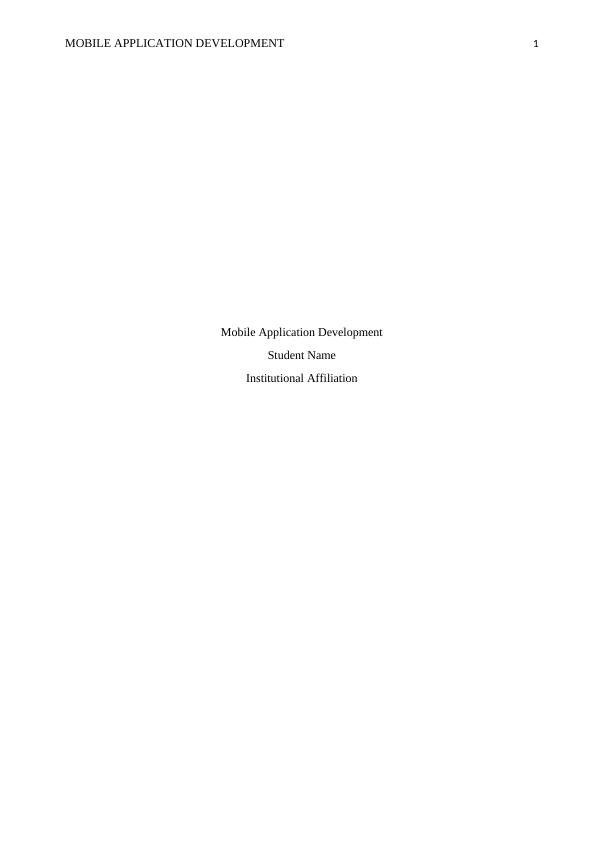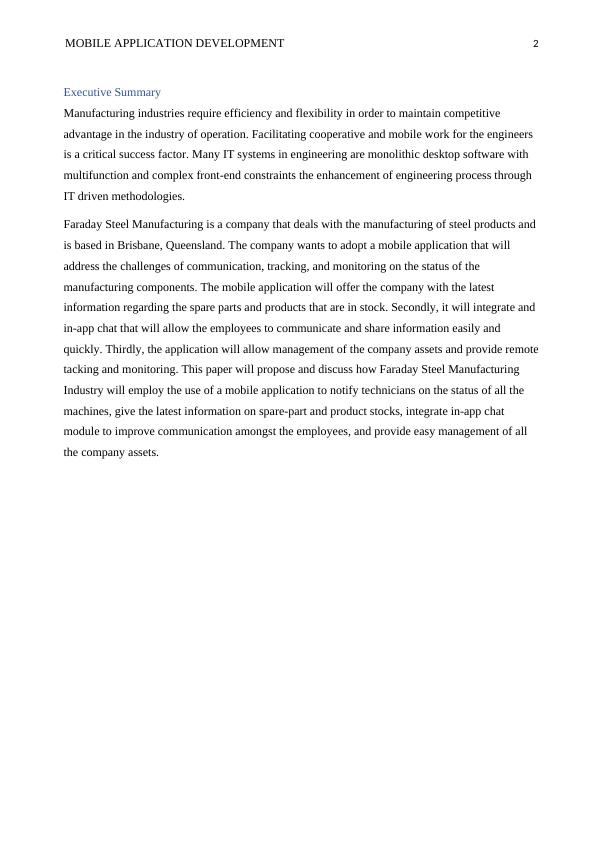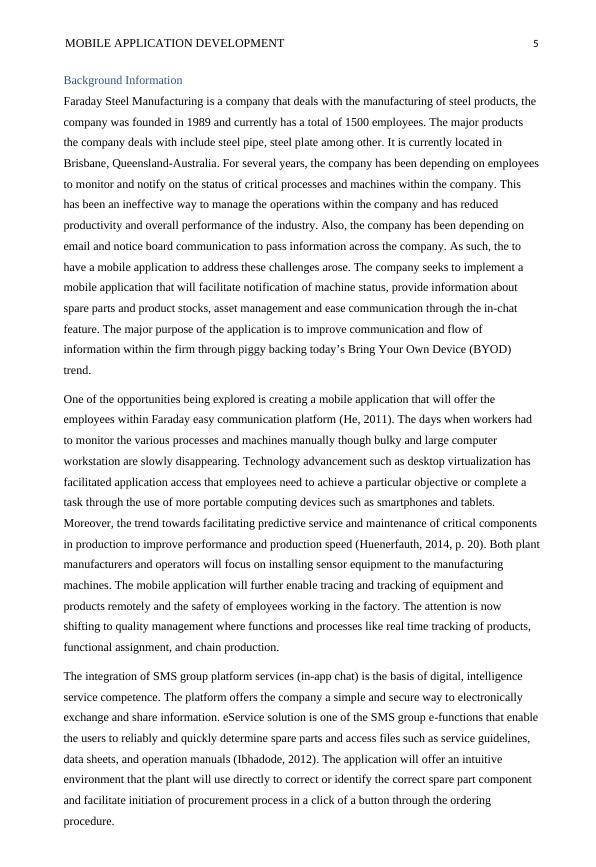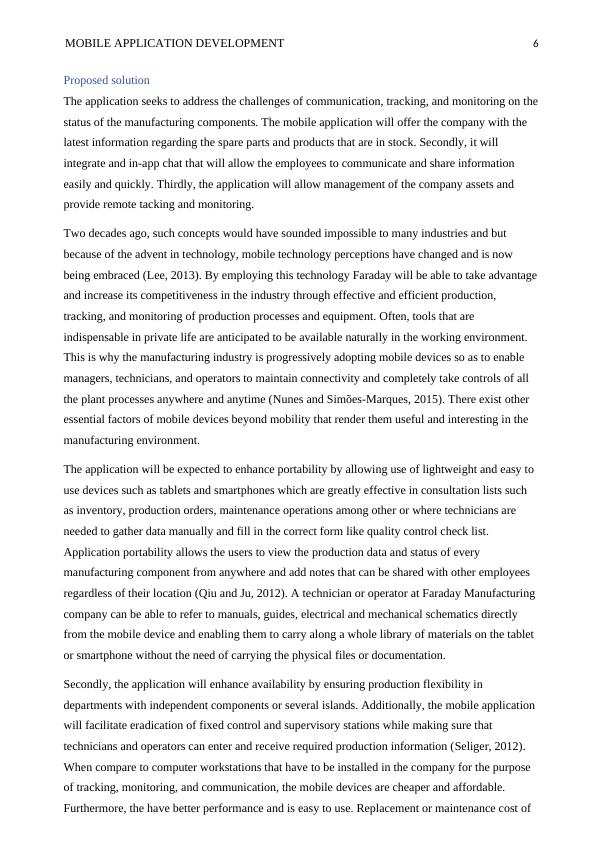Mobile Application Development for Faraday Steel Manufacturing Industry
Added on 2023-06-03
22 Pages7838 Words285 Views
MOBILE APPLICATION DEVELOPMENT 1
Mobile Application Development
Student Name
Institutional Affiliation
Mobile Application Development
Student Name
Institutional Affiliation

MOBILE APPLICATION DEVELOPMENT 2
Executive Summary
Manufacturing industries require efficiency and flexibility in order to maintain competitive
advantage in the industry of operation. Facilitating cooperative and mobile work for the engineers
is a critical success factor. Many IT systems in engineering are monolithic desktop software with
multifunction and complex front-end constraints the enhancement of engineering process through
IT driven methodologies.
Faraday Steel Manufacturing is a company that deals with the manufacturing of steel products and
is based in Brisbane, Queensland. The company wants to adopt a mobile application that will
address the challenges of communication, tracking, and monitoring on the status of the
manufacturing components. The mobile application will offer the company with the latest
information regarding the spare parts and products that are in stock. Secondly, it will integrate and
in-app chat that will allow the employees to communicate and share information easily and
quickly. Thirdly, the application will allow management of the company assets and provide remote
tacking and monitoring. This paper will propose and discuss how Faraday Steel Manufacturing
Industry will employ the use of a mobile application to notify technicians on the status of all the
machines, give the latest information on spare-part and product stocks, integrate in-app chat
module to improve communication amongst the employees, and provide easy management of all
the company assets.
Executive Summary
Manufacturing industries require efficiency and flexibility in order to maintain competitive
advantage in the industry of operation. Facilitating cooperative and mobile work for the engineers
is a critical success factor. Many IT systems in engineering are monolithic desktop software with
multifunction and complex front-end constraints the enhancement of engineering process through
IT driven methodologies.
Faraday Steel Manufacturing is a company that deals with the manufacturing of steel products and
is based in Brisbane, Queensland. The company wants to adopt a mobile application that will
address the challenges of communication, tracking, and monitoring on the status of the
manufacturing components. The mobile application will offer the company with the latest
information regarding the spare parts and products that are in stock. Secondly, it will integrate and
in-app chat that will allow the employees to communicate and share information easily and
quickly. Thirdly, the application will allow management of the company assets and provide remote
tacking and monitoring. This paper will propose and discuss how Faraday Steel Manufacturing
Industry will employ the use of a mobile application to notify technicians on the status of all the
machines, give the latest information on spare-part and product stocks, integrate in-app chat
module to improve communication amongst the employees, and provide easy management of all
the company assets.

MOBILE APPLICATION DEVELOPMENT 3
Table of Contents
Executive Summary............................................................................................................................2
Introduction........................................................................................................................................4
Background Information.....................................................................................................................5
Proposed solution...............................................................................................................................6
Cost Analysis......................................................................................................................................7
Strategic Alignment between Business and IT strategies...................................................................8
Value Proposition.............................................................................................................................12
Project Management and Control.....................................................................................................13
Infrastructure Requirements.............................................................................................................14
Development Platform..................................................................................................................14
Coding Language and Tools.........................................................................................................14
Cloud Services..............................................................................................................................14
Software Design, Development Methodologies and Testing Strategies..........................................15
Internalization...................................................................................................................................16
Social Media Integration Strategies..................................................................................................16
Risk Management.............................................................................................................................16
Integration and Deployment Strategies............................................................................................17
User Acceptance and Change Management.....................................................................................18
Maintenance......................................................................................................................................18
Future Opportunities and Enhancements..........................................................................................19
Recommendation and Conclusion....................................................................................................19
References List.................................................................................................................................19
Table of Contents
Executive Summary............................................................................................................................2
Introduction........................................................................................................................................4
Background Information.....................................................................................................................5
Proposed solution...............................................................................................................................6
Cost Analysis......................................................................................................................................7
Strategic Alignment between Business and IT strategies...................................................................8
Value Proposition.............................................................................................................................12
Project Management and Control.....................................................................................................13
Infrastructure Requirements.............................................................................................................14
Development Platform..................................................................................................................14
Coding Language and Tools.........................................................................................................14
Cloud Services..............................................................................................................................14
Software Design, Development Methodologies and Testing Strategies..........................................15
Internalization...................................................................................................................................16
Social Media Integration Strategies..................................................................................................16
Risk Management.............................................................................................................................16
Integration and Deployment Strategies............................................................................................17
User Acceptance and Change Management.....................................................................................18
Maintenance......................................................................................................................................18
Future Opportunities and Enhancements..........................................................................................19
Recommendation and Conclusion....................................................................................................19
References List.................................................................................................................................19

MOBILE APPLICATION DEVELOPMENT 4
Introduction
Technology evolution and revolution has brought major changes in the engineering industry. The
increasing complexities in the engineering system has led to the need to employ technology
concepts. In today’s engineering environment, engineers and other engineering professionals
require applications and systems that will enable them to continuously update and develop their
knowledge and skills. In addition, the rise of mobile technology and online tools is gradually
bringing effectiveness and efficiency in the engineering environment which are key benefits in
increasing productivity and performance (Charland and LeRoux, 2011, p. 20). According to Yu,
Zhou, Gong and Chien (2015 p. 280), engineers are getting more constraint in the process of
application development because of the progressively accelerating and advancing technology
while budgets and timelines remaining the same. Because of this reason, engineers need to be
innovative and efficient and this can only be achieved through adoption of technology.
Competitive engineering companies are continuously seeking to deploy new technologies in their
operations which are necessary in simplifying and enhancing the design process. One of the major
objectives of mobile technology is to improve communications and sharing of critical information
within the company (Dong-Hoon and Jun-Yeob, 2013, p. 18). Adoption of mobile based
application has been welcomed by the engineering industry because of its ability to facilitate
remote communication and web accessibility to the design tools.
Individualization and globalization have led to higher complexities, shorter product life cycle, and
different products. These aspects require efficiency and flexibility in order to maintain competitive
advantage in the industry of operation. In such context, enabling cooperative and mobile work for
the engineers is a critical success factor. Many IT systems in engineering are monolithic desktop
software with multifunction and complex front-end constraints the enhancement of engineering
process through IT driven methodologies. With the rise of mobile computing (tablets and
smart[hones), the emergence of mobile application has facilitated anytime and anywhere properties
which are very essential in process optimization in the engineering industry (Eshet, 2012, p. 14).
Additionally, exploiting this technology offer a big potential for improved efficiency and
flexibility in engineering tasks. Technicians are getting real time notifications about the various
engineering processes that require their attention. In this paper, we discuss how Faraday Steel
Manufacturing Industry will employ the use of a mobile application to notify technicians on the
status of all the machines, give the latest information on spare-part and product stocks, integrate
in-app chat module to improve communication amongst the employees, and provide easy
management of all the company assets.
Introduction
Technology evolution and revolution has brought major changes in the engineering industry. The
increasing complexities in the engineering system has led to the need to employ technology
concepts. In today’s engineering environment, engineers and other engineering professionals
require applications and systems that will enable them to continuously update and develop their
knowledge and skills. In addition, the rise of mobile technology and online tools is gradually
bringing effectiveness and efficiency in the engineering environment which are key benefits in
increasing productivity and performance (Charland and LeRoux, 2011, p. 20). According to Yu,
Zhou, Gong and Chien (2015 p. 280), engineers are getting more constraint in the process of
application development because of the progressively accelerating and advancing technology
while budgets and timelines remaining the same. Because of this reason, engineers need to be
innovative and efficient and this can only be achieved through adoption of technology.
Competitive engineering companies are continuously seeking to deploy new technologies in their
operations which are necessary in simplifying and enhancing the design process. One of the major
objectives of mobile technology is to improve communications and sharing of critical information
within the company (Dong-Hoon and Jun-Yeob, 2013, p. 18). Adoption of mobile based
application has been welcomed by the engineering industry because of its ability to facilitate
remote communication and web accessibility to the design tools.
Individualization and globalization have led to higher complexities, shorter product life cycle, and
different products. These aspects require efficiency and flexibility in order to maintain competitive
advantage in the industry of operation. In such context, enabling cooperative and mobile work for
the engineers is a critical success factor. Many IT systems in engineering are monolithic desktop
software with multifunction and complex front-end constraints the enhancement of engineering
process through IT driven methodologies. With the rise of mobile computing (tablets and
smart[hones), the emergence of mobile application has facilitated anytime and anywhere properties
which are very essential in process optimization in the engineering industry (Eshet, 2012, p. 14).
Additionally, exploiting this technology offer a big potential for improved efficiency and
flexibility in engineering tasks. Technicians are getting real time notifications about the various
engineering processes that require their attention. In this paper, we discuss how Faraday Steel
Manufacturing Industry will employ the use of a mobile application to notify technicians on the
status of all the machines, give the latest information on spare-part and product stocks, integrate
in-app chat module to improve communication amongst the employees, and provide easy
management of all the company assets.

MOBILE APPLICATION DEVELOPMENT 5
Background Information
Faraday Steel Manufacturing is a company that deals with the manufacturing of steel products, the
company was founded in 1989 and currently has a total of 1500 employees. The major products
the company deals with include steel pipe, steel plate among other. It is currently located in
Brisbane, Queensland-Australia. For several years, the company has been depending on employees
to monitor and notify on the status of critical processes and machines within the company. This
has been an ineffective way to manage the operations within the company and has reduced
productivity and overall performance of the industry. Also, the company has been depending on
email and notice board communication to pass information across the company. As such, the to
have a mobile application to address these challenges arose. The company seeks to implement a
mobile application that will facilitate notification of machine status, provide information about
spare parts and product stocks, asset management and ease communication through the in-chat
feature. The major purpose of the application is to improve communication and flow of
information within the firm through piggy backing today’s Bring Your Own Device (BYOD)
trend.
One of the opportunities being explored is creating a mobile application that will offer the
employees within Faraday easy communication platform (He, 2011). The days when workers had
to monitor the various processes and machines manually though bulky and large computer
workstation are slowly disappearing. Technology advancement such as desktop virtualization has
facilitated application access that employees need to achieve a particular objective or complete a
task through the use of more portable computing devices such as smartphones and tablets.
Moreover, the trend towards facilitating predictive service and maintenance of critical components
in production to improve performance and production speed (Huenerfauth, 2014, p. 20). Both plant
manufacturers and operators will focus on installing sensor equipment to the manufacturing
machines. The mobile application will further enable tracing and tracking of equipment and
products remotely and the safety of employees working in the factory. The attention is now
shifting to quality management where functions and processes like real time tracking of products,
functional assignment, and chain production.
The integration of SMS group platform services (in-app chat) is the basis of digital, intelligence
service competence. The platform offers the company a simple and secure way to electronically
exchange and share information. eService solution is one of the SMS group e-functions that enable
the users to reliably and quickly determine spare parts and access files such as service guidelines,
data sheets, and operation manuals (Ibhadode, 2012). The application will offer an intuitive
environment that the plant will use directly to correct or identify the correct spare part component
and facilitate initiation of procurement process in a click of a button through the ordering
procedure.
Background Information
Faraday Steel Manufacturing is a company that deals with the manufacturing of steel products, the
company was founded in 1989 and currently has a total of 1500 employees. The major products
the company deals with include steel pipe, steel plate among other. It is currently located in
Brisbane, Queensland-Australia. For several years, the company has been depending on employees
to monitor and notify on the status of critical processes and machines within the company. This
has been an ineffective way to manage the operations within the company and has reduced
productivity and overall performance of the industry. Also, the company has been depending on
email and notice board communication to pass information across the company. As such, the to
have a mobile application to address these challenges arose. The company seeks to implement a
mobile application that will facilitate notification of machine status, provide information about
spare parts and product stocks, asset management and ease communication through the in-chat
feature. The major purpose of the application is to improve communication and flow of
information within the firm through piggy backing today’s Bring Your Own Device (BYOD)
trend.
One of the opportunities being explored is creating a mobile application that will offer the
employees within Faraday easy communication platform (He, 2011). The days when workers had
to monitor the various processes and machines manually though bulky and large computer
workstation are slowly disappearing. Technology advancement such as desktop virtualization has
facilitated application access that employees need to achieve a particular objective or complete a
task through the use of more portable computing devices such as smartphones and tablets.
Moreover, the trend towards facilitating predictive service and maintenance of critical components
in production to improve performance and production speed (Huenerfauth, 2014, p. 20). Both plant
manufacturers and operators will focus on installing sensor equipment to the manufacturing
machines. The mobile application will further enable tracing and tracking of equipment and
products remotely and the safety of employees working in the factory. The attention is now
shifting to quality management where functions and processes like real time tracking of products,
functional assignment, and chain production.
The integration of SMS group platform services (in-app chat) is the basis of digital, intelligence
service competence. The platform offers the company a simple and secure way to electronically
exchange and share information. eService solution is one of the SMS group e-functions that enable
the users to reliably and quickly determine spare parts and access files such as service guidelines,
data sheets, and operation manuals (Ibhadode, 2012). The application will offer an intuitive
environment that the plant will use directly to correct or identify the correct spare part component
and facilitate initiation of procurement process in a click of a button through the ordering
procedure.

MOBILE APPLICATION DEVELOPMENT 6
Proposed solution
The application seeks to address the challenges of communication, tracking, and monitoring on the
status of the manufacturing components. The mobile application will offer the company with the
latest information regarding the spare parts and products that are in stock. Secondly, it will
integrate and in-app chat that will allow the employees to communicate and share information
easily and quickly. Thirdly, the application will allow management of the company assets and
provide remote tacking and monitoring.
Two decades ago, such concepts would have sounded impossible to many industries and but
because of the advent in technology, mobile technology perceptions have changed and is now
being embraced (Lee, 2013). By employing this technology Faraday will be able to take advantage
and increase its competitiveness in the industry through effective and efficient production,
tracking, and monitoring of production processes and equipment. Often, tools that are
indispensable in private life are anticipated to be available naturally in the working environment.
This is why the manufacturing industry is progressively adopting mobile devices so as to enable
managers, technicians, and operators to maintain connectivity and completely take controls of all
the plant processes anywhere and anytime (Nunes and Simões-Marques, 2015). There exist other
essential factors of mobile devices beyond mobility that render them useful and interesting in the
manufacturing environment.
The application will be expected to enhance portability by allowing use of lightweight and easy to
use devices such as tablets and smartphones which are greatly effective in consultation lists such
as inventory, production orders, maintenance operations among other or where technicians are
needed to gather data manually and fill in the correct form like quality control check list.
Application portability allows the users to view the production data and status of every
manufacturing component from anywhere and add notes that can be shared with other employees
regardless of their location (Qiu and Ju, 2012). A technician or operator at Faraday Manufacturing
company can be able to refer to manuals, guides, electrical and mechanical schematics directly
from the mobile device and enabling them to carry along a whole library of materials on the tablet
or smartphone without the need of carrying the physical files or documentation.
Secondly, the application will enhance availability by ensuring production flexibility in
departments with independent components or several islands. Additionally, the mobile application
will facilitate eradication of fixed control and supervisory stations while making sure that
technicians and operators can enter and receive required production information (Seliger, 2012).
When compare to computer workstations that have to be installed in the company for the purpose
of tracking, monitoring, and communication, the mobile devices are cheaper and affordable.
Furthermore, the have better performance and is easy to use. Replacement or maintenance cost of
Proposed solution
The application seeks to address the challenges of communication, tracking, and monitoring on the
status of the manufacturing components. The mobile application will offer the company with the
latest information regarding the spare parts and products that are in stock. Secondly, it will
integrate and in-app chat that will allow the employees to communicate and share information
easily and quickly. Thirdly, the application will allow management of the company assets and
provide remote tacking and monitoring.
Two decades ago, such concepts would have sounded impossible to many industries and but
because of the advent in technology, mobile technology perceptions have changed and is now
being embraced (Lee, 2013). By employing this technology Faraday will be able to take advantage
and increase its competitiveness in the industry through effective and efficient production,
tracking, and monitoring of production processes and equipment. Often, tools that are
indispensable in private life are anticipated to be available naturally in the working environment.
This is why the manufacturing industry is progressively adopting mobile devices so as to enable
managers, technicians, and operators to maintain connectivity and completely take controls of all
the plant processes anywhere and anytime (Nunes and Simões-Marques, 2015). There exist other
essential factors of mobile devices beyond mobility that render them useful and interesting in the
manufacturing environment.
The application will be expected to enhance portability by allowing use of lightweight and easy to
use devices such as tablets and smartphones which are greatly effective in consultation lists such
as inventory, production orders, maintenance operations among other or where technicians are
needed to gather data manually and fill in the correct form like quality control check list.
Application portability allows the users to view the production data and status of every
manufacturing component from anywhere and add notes that can be shared with other employees
regardless of their location (Qiu and Ju, 2012). A technician or operator at Faraday Manufacturing
company can be able to refer to manuals, guides, electrical and mechanical schematics directly
from the mobile device and enabling them to carry along a whole library of materials on the tablet
or smartphone without the need of carrying the physical files or documentation.
Secondly, the application will enhance availability by ensuring production flexibility in
departments with independent components or several islands. Additionally, the mobile application
will facilitate eradication of fixed control and supervisory stations while making sure that
technicians and operators can enter and receive required production information (Seliger, 2012).
When compare to computer workstations that have to be installed in the company for the purpose
of tracking, monitoring, and communication, the mobile devices are cheaper and affordable.
Furthermore, the have better performance and is easy to use. Replacement or maintenance cost of

End of preview
Want to access all the pages? Upload your documents or become a member.
Related Documents
CSI800: Enterprise Mobile App Assignment 2022lg...
|26
|6577
|18
Operations Engineering: Samsung Case Study and Designing a New Product using De Bono’s Six Hat Thinking Modellg...
|32
|6945
|311
Information System Strategy Assignment - (DOC)lg...
|21
|5563
|140
CDS3007 | Report on E-businesslg...
|20
|4500
|66
Comparison of e-Business Companies in Australia: Analyzing B2B Models and Website Featureslg...
|26
|4395
|199
Project Scope Statement for McMillian Mobile Technology Projectlg...
|8
|1890
|180
